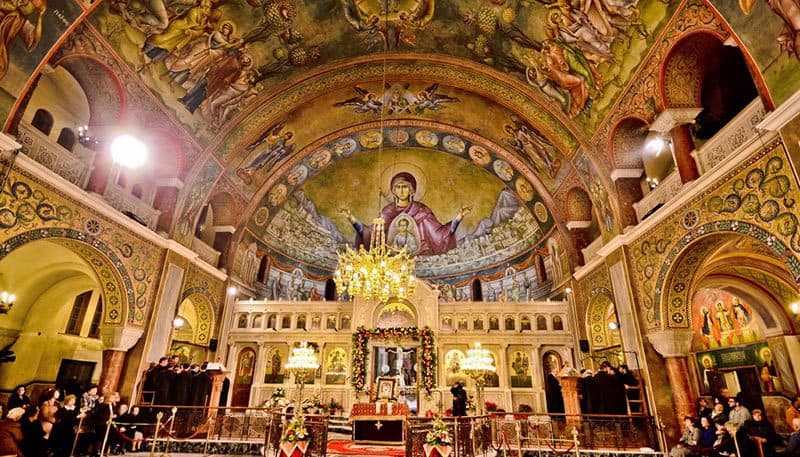General
The Orthodox Church
Nothing is accidental in the Orthodox Church. Everything has been meticulously studied and has its own utility and importance. The Fathers of our Church ordained the faithful entering the temple, to participate in worship and thanksgiving, to leave the worldly for the time being and to enter the realm of the supersensible. That is why everything in the temple has its deepest symbolism, so that the faithful are given saving messages.
The Orthodox Church is a miniature of the universe (visible and invisible). It is a visible point – a symbol – of what the human eye cannot see. The secret meaning of the temple is revealed only to the initiates, to the faithful.
The dome symbolizes the sky.
Candles and chandeliers symbolize the stars of the celestial dome.
The Holy Step symbolizes Paradise, the Upper Jerusalem (Rev. 21: 2), in which the heavenly Divine Liturgy is performed incessantly, with angels officiating
The Holy Table symbolizes the Throne of the Slaughtered Lamb (Rev. Rev.22: 3).
The covers of the Holy Table symbolize the sacred savannah and the shroud, with which the colorless Body of Christ was wrapped during His divine burial
Priests symbolize the holy angels, the liturgical spirits of God (Heb. 1:14),
Their sacred vestments also have their symbolism. Their brilliance and purity symbolize the priestly grace they are clothed with.
The earth is symbolized by the floor of the temple. There stand the faithful, who make up the militant Church on earth and gaze at the sky (dome), Paradise (holy step) and the depicted saints
The Holy Table usually rests on a pillar, which symbolizes the helpless pillar of the Church, Christ, or on four pillars that symbolize the four Evangelists.
On the Holy Table there is the Holy Gospel, which symbolizes the true presence of Christ in the Church and the fact that the Church preserves the Truth.
There is also the Cross of Blessing, which symbolizes the invincible power of the Church against evil.
The candlesticks, which symbolize the unquenchable light of Christian teaching.
Behind the Holy Table there are the six wings, metal banners with representations of angelic figures that radiate. They certainly symbolize the angelic order of the six-winged angels, which is honored in the presence of God (Isa. 6: 1-2; Rev. 4: 6-8).
On the northeast side of the sanctuary there is the niche of the sacred Intention, which symbolizes the sacred cave of the Nativity of the Lord.
The pulpit symbolizes the tomb of Christ and the deacon the angel of the Resurrection (Mark 16: 6). It has representations of the holy Evangelists and there is a relief dove, on which the holy Gospel is placed and symbolizes the Holy Spirit.
At the front of the sole are the large manuals, which together with the lamps of the iconostasis, in addition to the light they emit, symbolize the imaginary light of Christ, which “seems to pass”. The same goes for the chandeliers or the combination which hang from the ceiling and symbolize the light of Christ and the illumination of the Holy Spirit, which descends from heaven.
The candles symbolize our soul, which should be as pure as light and burning like fire from longing for its union with Christ.
The auspicious bells invite the faithful to come to the Church. They take their name from Campania, a region of Italy where they were first built. They symbolize the trumpets of the angels for awakening.
In the temple the believer makes the great transcendence of time and space. While on earth he participates in heaven, while he is part of the material world, he communicates with the world of mental and spiritual powers, while he lives within the constraints of time, he tastes eternity. The earth and the sky are mixed every Sunday and every festive day in the Divine Liturgy… To go to the Liturgy on Sunday really means to leave your home and go to heaven wrote the great Romanian poet and writer V. Gheorghiu (A Name for Eternity, Athens 1972, pp. 105,139).
Inside the Orthodox Church is experienced the most joyful event in human history, the victory of life over death, through the triumphant Resurrection of Christ. Our Orthodox Catholic Church has rightly been described as the Church of the Resurrection, because it lives and experiences uninterruptedly the event of the Resurrection. Orthodox life is a lasting Easter! The temple perfectly expresses this reality. The iconography, from the iconic representations of the Resurrection, to the depicted figures of the saints, expresses the migratory reality of the Church. Every Sunday the Resurrection of the Lord is joyfully celebrated, the services are resurrected and strict fasting is forbidden. Believers feel this dimension and rejoice in victory over death and decay and taste immortality and eternity.
The temple is the second home of the believer. An infant being there is driven for sprinkling. In the temple he receives the Holy Baptism and is reborn in a new existence in Christ. There he is crowned and shares the joy of his marriage with the whole local church. There he enjoys the joys of the big holidays. In the temple he rejoices in the baptism of his children. There he participates in the sacred mysteries and receives the redemptive grace of God. In him he hurries to pray for the difficulties of life and to draw strength for the course of his life. There he is led to the end of his life on earth, for his exit sequence. Memorial prayers for him and for all the sleeping believers will be returned to the temple.

